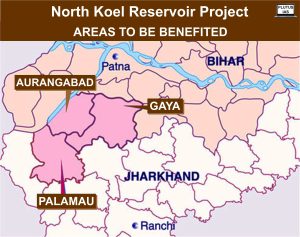31 Oct North Koel Reservoir Project
This article covers “Daily Current Affairs” and the topic details “ North Koel Reservoir Project”. This topic has relevance in the section of the UPSC CSE exam.
GS 3: Environment
Why in the news?
The Cabinet Committee on Economic Affairs has granted approval for the revised project cost, aiming to revive the stalled North Koel Reservoir Project situated in both Jharkhand and Bihar.
North Koel Reservoir Project:
- Inter-State Major Irrigation Project: The North Koel Reservoir Project is a significant inter-state irrigation project with its command area spanning across the states of Bihar and Jharkhand.
- Project Components: The project includes a dam built on the North Koel River near Kutku Village in Latehar District, Jharkhand. Additionally, it features a barrage situated 96 km downstream of the dam, located in Palamu district, Jharkhand. The project comprises a Right Main Canal and a Left Main Canal that divert water from the barrage for various purposes.
- Historical Background: The proposal for the dam dates back to 1927, and construction commenced in 1972. However, concerns emerged that the dam’s water could potentially pose a threat to the Betla National Park and the Palamu Tiger Reserve.

North Koel River:
- River Origin: The North Koel River is the second-largest right bank tributary of the River Sone. It originates in the Ranchi Plateau and enters the Palamau division, located below Netarhat near Rud.
- Confluence: The North Koel River meets the Sone River in Haidargarh, Palamu district, Jharkhand.
- Tributaries: Notable tributaries of the North Koel River include the Auranga, Amanat, and Burha Rivers.
- Wildlife and Conservation: The North Koel River serves as the northern boundary of the Betla National Park, contributing to the conservation of the region’s biodiversity.
Betla National Park:
- Jharkhand’s Sole National Park: Betla National Park is the only national park within the state of Jharkhand, India.
- Geographical Location: Situated on the western part of the Chhotanagpur plateau, Betla National Park showcases diverse landscapes and natural beauty.
- A section of Betla National Park was designated as the Palamu Tiger Reserve, which was one of the first nine Tiger Reserves declared in 1974. This reserve remains the sole Tiger Reserve in Jharkhand.
- The northern region of Betla National Park is traversed by the River Koel and its tributaries, enhancing the park’s ecological significance.
- Flora: The national park features a rich flora, including tropical wet evergreen forests in lower regions, mixed deciduous forests in the middle, and temperate alpine forests in higher altitudes. Sal and bamboo forests dominate a significant part of the park’s landscape.
- Fauna: Betla National Park is home to a diverse range of wildlife, such as elephants, leopards, panthers, monkeys, Indian civets, chital, bison, sloth bears, sambhar, nilgai, langurs, mouse deer, porcupines, and chinkara.
- Indian Grey Wolf: Notably, Betla National Park and Palamu Tiger Reserve are dedicated to the conservation of the Indian Grey Wolf, with a thriving population. It is the only wildlife sanctuary with a specific focus on the Indian Grey Wolf.
- Historical Significance: The first-ever tiger census through pug mark counting was conducted within these forests in 1934, contributing to India’s wildlife conservation efforts.
- Netarhat Hill Station: The famous hill station of Netarhat is located on the southern fringes of Betla National Park/Palamu Tiger Reserve.
Palamu Tiger Reserve:
- Chero Dynasty Forts: Within the Palamu Tiger Reserve, there are forts built by the Chero dynasty. The Cheros, also known as the Chyavana dynasty, ruled over regions encompassing Bihar, Uttar Pradesh, and Jharkhand from the 12th to the 19th century.
Download plutus ias current affairs eng med 31st Oct 2023
Q.1 Consider the following statements regarding the Koel River:
- The Koel River is the largest left bank tributary of the River Sone.
- It originates in the Ranchi Plateau.
- Notable tributaries of the North Koel River include the Auranga, Amanat, and Burha Rivers.
How many of the above statement/s is/are correct?
(a) Only one
(b) Only two
(c) All three
(d) None
Q.2 Consider the following statements about Betla National Park:
- Betla National Park is situated in the state of Assam, India.
- Betla National Park is renowned for its population of Asiatic lions.
Which of the statements given above is/are correct?
(a) 1 only
(b) 2 only
(c) Both 1 and 2
(d) Neither 1 nor 2
Q.3 Discuss the significance and impact of hydropower projects. Analyze the measures required to mitigate adverse effects and promote sustainable hydropower projects in the context of a country’s energy strategy and environmental conservation.



No Comments